Influence of Starch Composition and Molecular Weight on Physicochemical Properties of Biodegradable Films
Abstract
1. Introduction
2. Materials and Methods
2.1. Materials
2.2. Starch Grains Characterization
2.3. Preparation of TPS Films
2.4. Film Characterization
2.4.1. Film Thickness
2.4.2. Hydration Properties
2.4.3. Migration into Food Simulants
2.4.4. Transparency
2.4.5. Scanning Electron Microscopy (SEM)
2.4.6. Atomic Force Microscopy (AFM)
2.4.7. Mechanical Properties
2.4.8. X-ray Diffraction (XRD) Studies
3. Results and Discussion
3.1. Starch Characterization
3.2. Characterization of Starch-Based Films
3.2.1. Hydration Properties
3.2.2. Migration into Food Simulants
3.2.3. Transparency
3.2.4. Scanning Electron Microscopy (SEM)
3.2.5. Atomic Force Microscopy (AFM)
3.2.6. X-ray Diffraction (XRD) Studies
3.2.7. Mechanical Properties
4. Conclusions
Author Contributions
Funding
Acknowledgments
Conflicts of Interest
References
- Luchese, C.L.; Garrido, T.; Spada, J.C.; Tessaro, I.C.; de la Caba, K. Development and characterization of cassava starch films incorporated with blueberry pomace. Int. J. Biol. Macromol. 2018, 106, 834–839. [Google Scholar] [CrossRef] [PubMed]
- Liu, Y.; Mo, X.; Pang, J.; Yang, F. Effects of silica on the morphology, structure, and properties of thermoplastic cassava starch/poly(vinyl alcohol) blends. J. Appl. Polym. Sci. 2016, 133. [Google Scholar] [CrossRef]
- Hornung, P.S.; Ávila, S.; Masisi, K.; Malunga, L.N.; Lazzarotto, M.; Schnitzler, E.; Ribani, R.H.; Beta, T. Green Development of Biodegradable Films Based on Native Yam (Dioscoreaceae) Starch Mixtures. Starch-Stärke 2018, 70, 1700234. [Google Scholar] [CrossRef]
- Oliveira, A.V.; da Silva, A.P.M.; Barros, M.O.; de sá, M.; Souza Filho, M.; Rosa, M.F.; Azeredo, H.M.C. Nanocomposite Films from Mango Kernel or Corn Starch with Starch Nanocrystals. Starch-Stärke 2018, 70, 1800028. [Google Scholar] [CrossRef]
- Domene-López, D.; Guillén, M.M.; Martin-Gullon, I.; García-Quesada, J.C.; Montalbán, M.G. Study of the behavior of biodegradable starch/polyvinyl alcohol/rosin blends. Carbohydr. Polym. 2018, 202, 299–305. [Google Scholar] [CrossRef] [PubMed]
- Nogueira, G.F.; Fakhouri, F.M.; de Oliveira, R.A. Extraction and characterization of arrowroot (Maranta arundinaceae L.) starch and its application in edible films. Carbohydr. Polym. 2018, 186, 64–72. [Google Scholar] [CrossRef] [PubMed]
- Cano, A.; Fortunati, E.; Cháfer, M.; Kenny, J.M.; Chiralt, A.; González-Martínez, C. Properties and ageing behaviour of pea starch films as affected by blend with poly(vinyl alcohol). Food Hydrocoll. 2015, 48, 84–93. [Google Scholar] [CrossRef]
- Luchese, C.L.; Benelli, P.; Spada, J.C.; Tessaro, I.C. Impact of the starch source on the physicochemical properties and biodegradability of different starch-based films. J. Appl. Polym. Sci. 2018, 135, 46564. [Google Scholar] [CrossRef]
- Basiak, E.; Lenart, A.; Debeaufort, F. Effect of starch type on the physico-chemical properties of edible films. Int. J. Biol. Macromol. 2017, 98, 348–356. [Google Scholar] [CrossRef] [PubMed]
- Dai, L.; Zhang, J.; Cheng, F. Effects of starches from different botanical sources and modification methods on physicochemical properties of starch-based edible films. Int. J. Biol. Macromol. 2019, 132, 897–905. [Google Scholar] [CrossRef]
- Medina-Jaramillo, C.; Ochoa-Yepes, O.; Bernal, C.; Famá, L. Active and smart biodegradable packaging based on starch and natural extracts. Carbohydr. Polym. 2017, 176, 187–194. [Google Scholar] [CrossRef]
- Commission Regulation. Commission Regulation (EU) No. 10/2011 of 14 January 2011 on plastic materials and articles intended to come into contact with food. Off J. Eur. Union 2011, 12, 1–89. [Google Scholar]
- ASTM D882-12 Standard Test Method for Tensile Properties of Thin Plastic Sheeting; ASTM International: West Conshohocken, PA, USA, 2012; Available online: https://www.astm.org/DATABASE.CART/HISTORICAL/D882-02.htm (accessed on 28 March 2018).
- Luchese, C.L.; Spada, J.C.; Tessaro, I.C. Starch content affects physicochemical properties of corn and cassava starch-based films. Ind. Crop. Prod. 2017, 109, 619–626. [Google Scholar] [CrossRef]
- Desse, M.; Fraiseau, D.; Mitchell, J.; Budtova, T. Individual swollen starch granules under mechanical stress: Evidence for deformation and volume loss. Soft Matter 2010, 6, 363–369. [Google Scholar] [CrossRef]
- Deladino, L.; Teixeira, A.S.; Navarro, A.S.; Alvarez, I.; Molina-García, A.D.; Martino, M. Corn starch systems as carriers for yerba mate (Ilex paraguariensis) antioxidants. Food Bioprod. Process. 2015, 94, 463–472. [Google Scholar] [CrossRef]
- Malmir, S.; Montero, B.; Rico, M.; Barral, L.; Bouza, R.; Farrag, Y. Effects of poly(3-hydroxybutyrate-co-3-hydroxyvalerate) microparticles on morphological, mechanical, thermal, and barrier properties in thermoplastic potato starch films. Carbohydr. Polym. 2018, 194, 357–364. [Google Scholar] [CrossRef] [PubMed]
- Shi, R.; Zhu, A.; Chen, D.; Jiang, X.; Xu, X.; Zhang, L.; Tian, W. In vitro degradation of starch/PVA films and biocompatibility evaluation. J. Appl. Polym. Sci. 2010, 115, 346–357. [Google Scholar] [CrossRef]
- Mali, S.; Karam, L.B.; Ramos, L.P.; Grossmann, M.V.E. Relationships among the Composition and Physicochemical Properties of Starches with the Characteristics of Their Films. J. Agric. Food Chem. 2004, 52, 7720–7725. [Google Scholar] [CrossRef]
- Blennow, A.; Engelsen, S.B. Helix-breaking news: Fighting crystalline starch energy deposits in the cell. Trends Plant Sci. 2010, 15, 236–240. [Google Scholar] [CrossRef] [PubMed]
- Wickramasinghe, H.A.M.; Blennow, A.; Noda, T. Physico-chemical and degradative properties of in-planta re-structured potato starch. Carbohydr. Polym. 2009, 77, 118–124. [Google Scholar] [CrossRef]
- Zhang, B.; Zhao, Y.; Li, X.; Zhang, P.; Li, L.; Xie, F.; Chen, L. Effects of amylose and phosphate monoester on aggregation structures of heat-moisture treated potato starches. Carbohydr. Polym. 2014, 103, 228–233. [Google Scholar] [CrossRef]
- Blennow, A. Phosphorylation of the Starch Granule. In Starch: Metabolism and Structure; Nakamura, Y., Ed.; Springer Japan: Tokyo, Japan, 2015; pp. 399–424. ISBN 978-4-431-55495-0. [Google Scholar]
- Lawton, J.W. Effect of starch type on the properties of starch containing films. Polymers 1996, 29, 203–208. [Google Scholar] [CrossRef]
- Medina Jaramillo, C.; González Seligra, P.; Goyanes, S.; Bernal, C.; Famá, L. Biofilms based on cassava starch containing extract of yerba mate as antioxidant and plasticizer. Starch-Stärke 2015, 67, 780–789. [Google Scholar] [CrossRef]
- Zhong, Y.; Li, Y.; Liang, W.; Liu, L.; Li, S.; Xue, J.; Guo, D. Comparison of gelatinization method, starch concentration, and plasticizer on physical properties of high-amylose starch films. J. Food Process Eng. 2017, 41, 1–8. [Google Scholar] [CrossRef]
- Basiak, E.; Lenart, A.; Debeaufort, F. How Glycerol and Water Contents Affect the Structural and Functional Properties of Starch-Based Edible Films. Polymers 2018, 10, 412. [Google Scholar] [CrossRef] [PubMed]
- Moreno, O.; Cárdenas, J.; Atarés, L.; Chiralt, A. Influence of starch oxidation on the functionality of starch-gelatin based active films. Carbohydr. Polym. 2017, 178, 147–158. [Google Scholar] [CrossRef] [PubMed]
- González, K.; Martin, L.; González, A.; Retegi, A.; Eceiza, A.; Gabilondo, N. D-isosorbide and 1,3-propanediol as plasticizers for starch-based films: Characterization and aging study. J. Appl. Polym. Sci. 2017, 134, 44793. [Google Scholar] [CrossRef]
- Hizukuri, S. Relationship between the distribution of the chain length of amylopectin and the crystalline structure of starch granules. Carbohydr. Res. 1985, 141, 295–306. [Google Scholar] [CrossRef]
- Gutiérrez, T.J.; Tapia, M.S.; Pérez, E.; Famá, L. Edible films based on native and phosphated 80:20 waxy:normal corn starch. Starch-Stärke 2015, 67, 90–97. [Google Scholar]
- Lopez, O.; Garcia, M.A.; Villar, M.A.; Gentili, A.; Rodriguez, M.S.; Albertengo, L. Thermo-compression of biodegradable thermoplastic corn starch films containing chitin and chitosan. LWT-Food Sci. Technol. 2014, 57, 106–115. [Google Scholar] [CrossRef]
- Hosseini, S.F.; Rezaei, M.; Zandi, M.; Ghavi, F.F. Preparation and functional properties of fish gelatin–chitosan blend edible films. Food Chem. 2013, 136, 1490–1495. [Google Scholar] [CrossRef] [PubMed]
- Monteiro, M.K.S.; Oliveira, V.R.L.; Santos, F.K.G.; Barros Neto, E.L.; Leite, R.H.L.; Aroucha, E.M.M.; Silva, R.R.; Silva, K.N.O. Incorporation of bentonite clay in cassava starch films for the reduction of water vapor permeability. Food Res. Int. 2018, 105, 637–644. [Google Scholar] [CrossRef]
- Sreekumar, P.A.; Al-Harthi, M.A.; De, S.K. Studies on compatibility of biodegradable starch/polyvinyl alcohol blends. Polym. Eng. Sci. 2012, 52, 2167–2172. [Google Scholar] [CrossRef]
- Hulleman, S.H.; Kalisvaart, M.; Janssen, F.H.; Feil, H.; Vliegenthart, J.F. Origins of B-type crystallinity in glycerol-plasticised, compression-moulded potato starches. Carbohydr. Polym. 1999, 39, 351–360. [Google Scholar] [CrossRef]
- Morales, N.J.; Candal, R.; Famá, L.; Goyanes, S.; Rubiolo, G.H. Improving the physical properties of starch using a new kind of water dispersible nano-hybrid reinforcement. Carbohydr. Polym. 2015, 127, 291–299. [Google Scholar] [CrossRef]
- Phetwarotai, W.; Potiyaraj, P.; Aht-Ong, D. Characteristics of biodegradable polylactide/gelatinized starch films: Effects of starch, plasticizer, and compatibilizer. J. Appl. Polym. Sci. 2012, 126, E162–E172. [Google Scholar] [CrossRef]
- Angellier, H.; Molina-Boisseau, S.; Dole, P.; Dufresne, A. Thermoplastic Starch−Waxy Maize Starch Nanocrystals Nanocomposites. Biomacromolecules 2006, 7, 531–539. [Google Scholar] [CrossRef]
- Lopez-Rubio, A.; Flanagan, B.M.; Gilbert, E.P.; Gidley, M.J. A novel approach for calculating starch crystallinity and its correlation with double helix content: A combined XRD and NMR study. Biopolymers 2008, 89, 761–768. [Google Scholar] [CrossRef] [PubMed]
- Chen, X.; Hou, G.; Chen, Y.; Yang, K.; Dong, Y.; Zhou, H. Effect of molecular weight on crystallization, melting behavior and morphology of poly (trimethylene terephalate). Polym. Test. 2007, 26, 144–153. [Google Scholar] [CrossRef]
- Bhagabati, P.; Hazarika, D.; Katiyar, V. Tailor-made ultra-crystalline, high molecular weight poly(ε-caprolactone) films with improved oxygen gas barrier and optical properties: A facile and scalable approach. Int. J. Biol. Macromol. 2019, 124, 1040–1052. [Google Scholar] [CrossRef]
- Rindlav-Westling, A.; Stading, M.; Hermansson, A.-M.; Gatenholm, P. Structure, mechanical and barrier properties of amylose and amylopectin films. Carbohydr. Polym. 1998, 36, 217–224. [Google Scholar] [CrossRef]
- Velasquez, D.; Pavon-Djavid, G.; Chaunier, L.; Meddahi-Pellé, A.; Lourdin, D. Effect of crystallinity and plasticizer on mechanical properties and tissue integration of starch-based materials from two botanical origins. Carbohydr. Polym. 2015, 124, 180–187. [Google Scholar] [CrossRef] [PubMed]
- Xie, F.; Flanagan, B.M.; Li, M.; Sangwan, P.; Truss, R.W.; Halley, P.J.; Strounina, E.V.; Whittaker, A.K.; Gidley, M.J.; Dean, K.M.; et al. Characteristics of starch-based films plasticised by glycerol and by the ionic liquid 1-ethyl-3-methylimidazolium acetate: A comparative study. Carbohydr. Polym. 2014, 111, 841–848. [Google Scholar] [CrossRef]
- Li, M.; Xie, F.; Hasjim, J.; Witt, T.; Halley, P.J.; Gilbert, R.G. Establishing whether the structural feature controlling the mechanical properties of starch films is molecular or crystalline. Carbohydr. Polym. 2015, 117, 262–270. [Google Scholar] [CrossRef]
- Paes, S.S.; Yakimets, I.; Mitchell, J.R. Influence of gelatinization process on functional properties of cassava starch films. Food Hydrocoll. 2008, 22, 788–797. [Google Scholar] [CrossRef]
- Cano, A.; Jiménez, A.; Cháfer, M.; Gónzalez, C.; Chiralt, A. Effect of amylose:amylopectin ratio and rice bran addition on starch films properties. Carbohydr. Polym. 2014, 111, 543–555. [Google Scholar] [CrossRef]
- Talja, R.A.; Helén, H.; Roos, Y.H.; Jouppila, K. Effect of various polyols and polyol contents on physical and mechanical properties of potato starch-based films. Carbohydr. Polym. 2007, 67, 288–295. [Google Scholar] [CrossRef]
- Pushpadass, H.A.; Kumar, A.; Jackson, D.S.; Wehling, R.L.; Dumais, J.J.; Hanna, M.A. Macromolecular Changes in Extruded Starch-Films Plasticized with Glycerol, Water and Stearic Acid. Starch-Stärke 2009, 61, 256–266. [Google Scholar] [CrossRef]
- García, M.A.; Martino, M.N.; Zaritzky, N.E. Microstructural Characterization of Plasticized Starch-Based Films. Starch-Stärke 2000, 52, 118–124. [Google Scholar]
- Li, M.; Liu, P.; Zou, W.; Yu, L.; Xie, F.; Pu, H.; Liu, H.; Chen, L. Extrusion processing and characterization of edible starch films with different amylose contents. J. Food Eng. 2011, 106, 95–101. [Google Scholar] [CrossRef]
- Muscat, D.; Adhikari, B.; Adhikari, R.; Chaudhary, D.S. Comparative study of film forming behaviour of low and high amylose starches using glycerol and xylitol as plasticizers. J. Food Eng. 2012, 109, 189–201. [Google Scholar] [CrossRef]
- Colussi, R.; Zanella Pinto, V.; Lisie, S.; Halal, S.L.M.E.; Biduski, B.; Prietto, L.; Castilhos, D.D.; Zavareze, E.R.; Guerra Dias, A.R. Acetylated rice starches films with different levels of amylose: Mechanical, water vapor barrier, thermal, and biodegradability properties. Food Chem. 2017, 221, 1614–1620. [Google Scholar] [CrossRef] [PubMed]
- Kormin, S.; Kormin, F.; Beg, M.D.H.; Piah, M.B.M. Physical and mechanical properties of LDPE incorporated with different starch sources. In Proceedings of the IOP Conference Series: Materials Science and Engineering, Melaka, Malaysia, 6–7 May 2017; Volume 226, p. 012157. [Google Scholar]
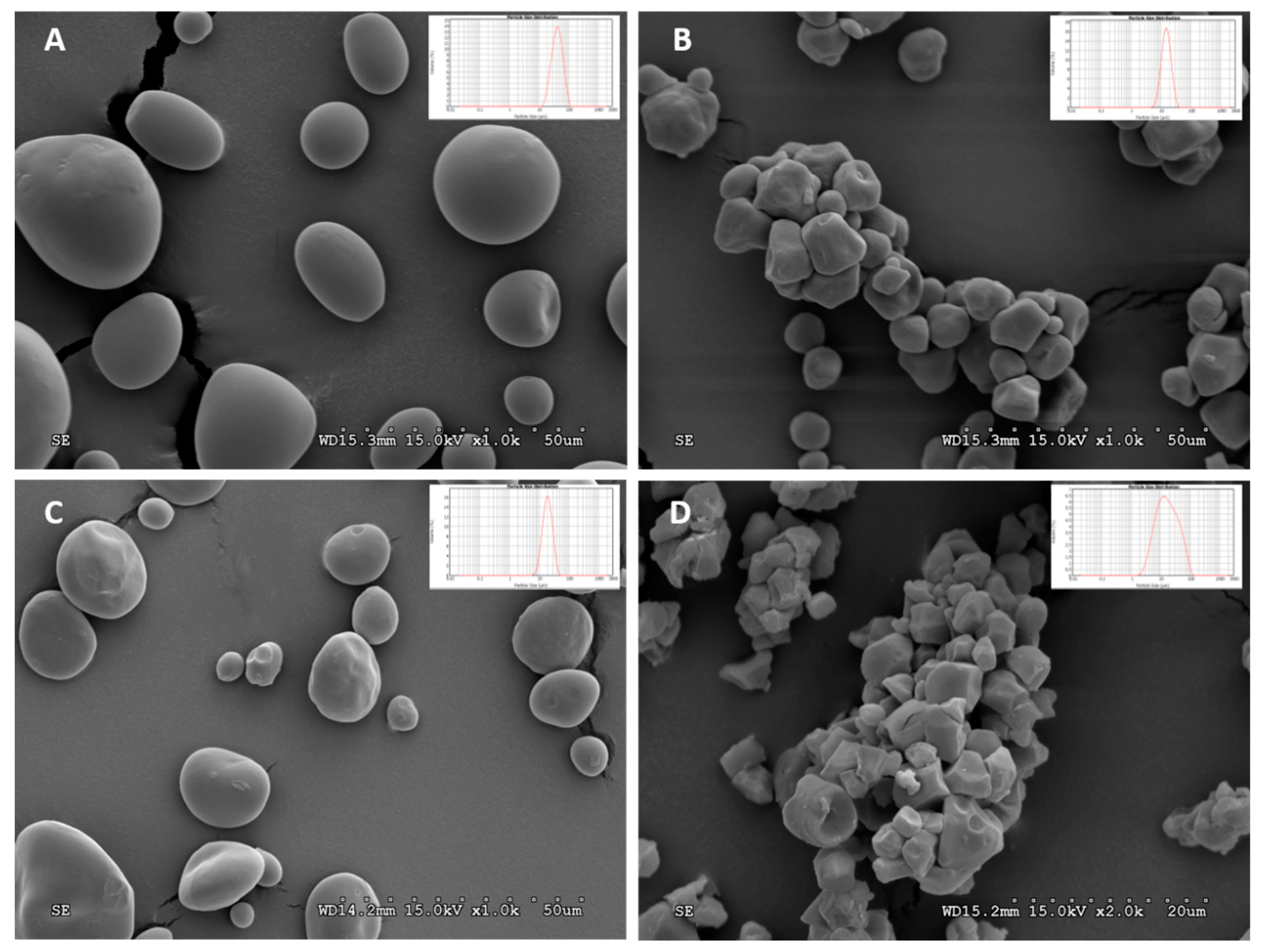

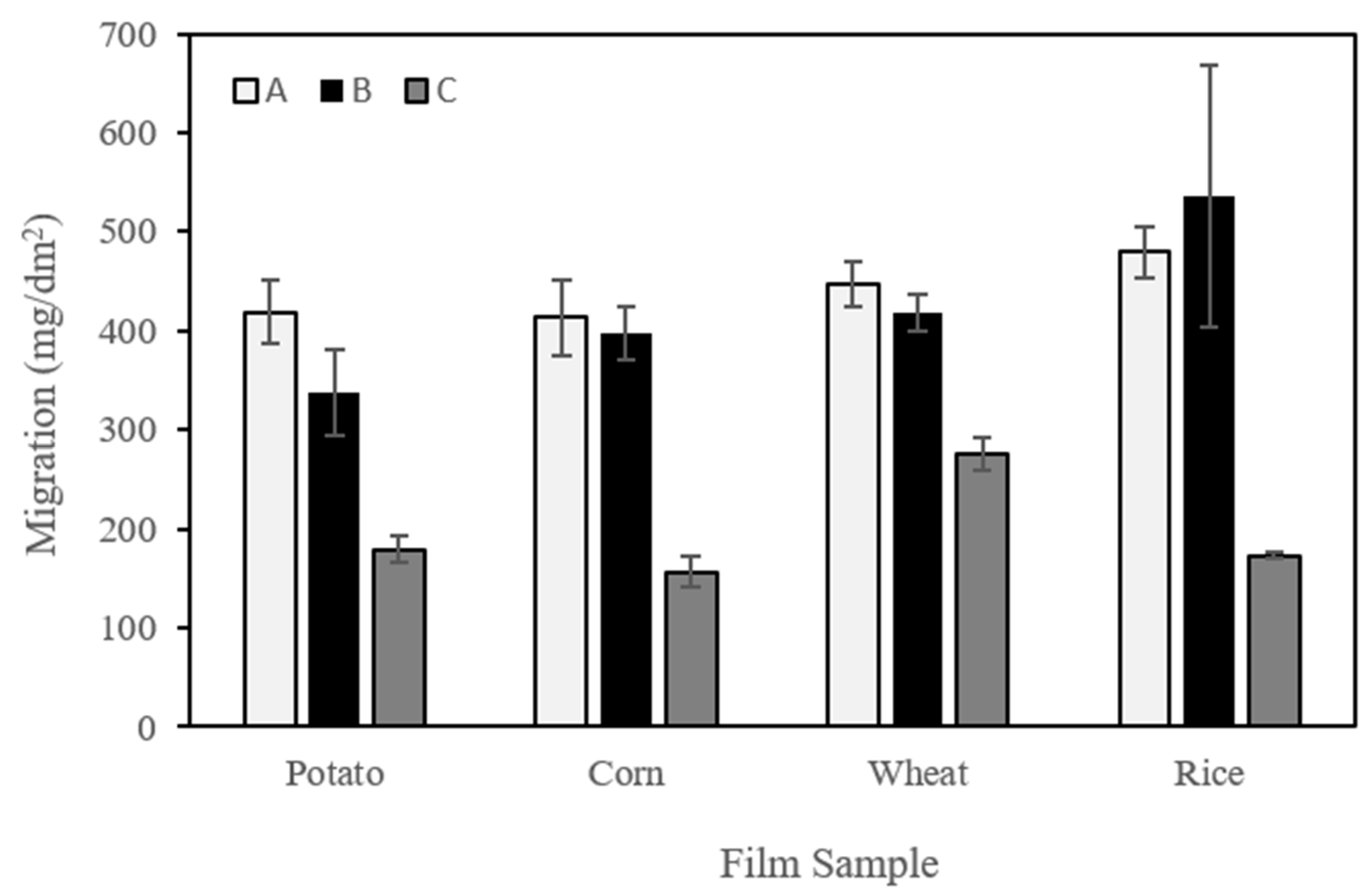
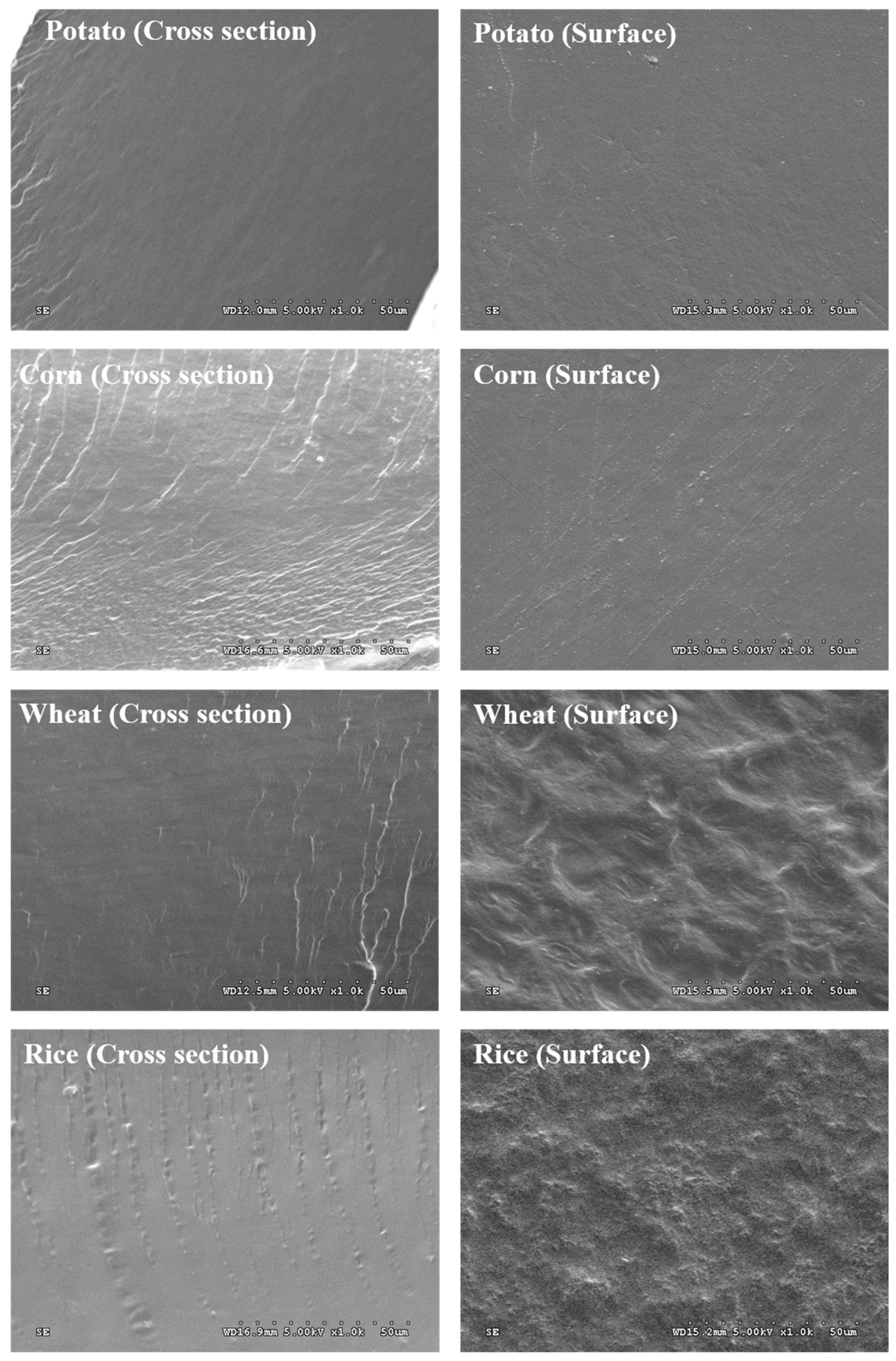
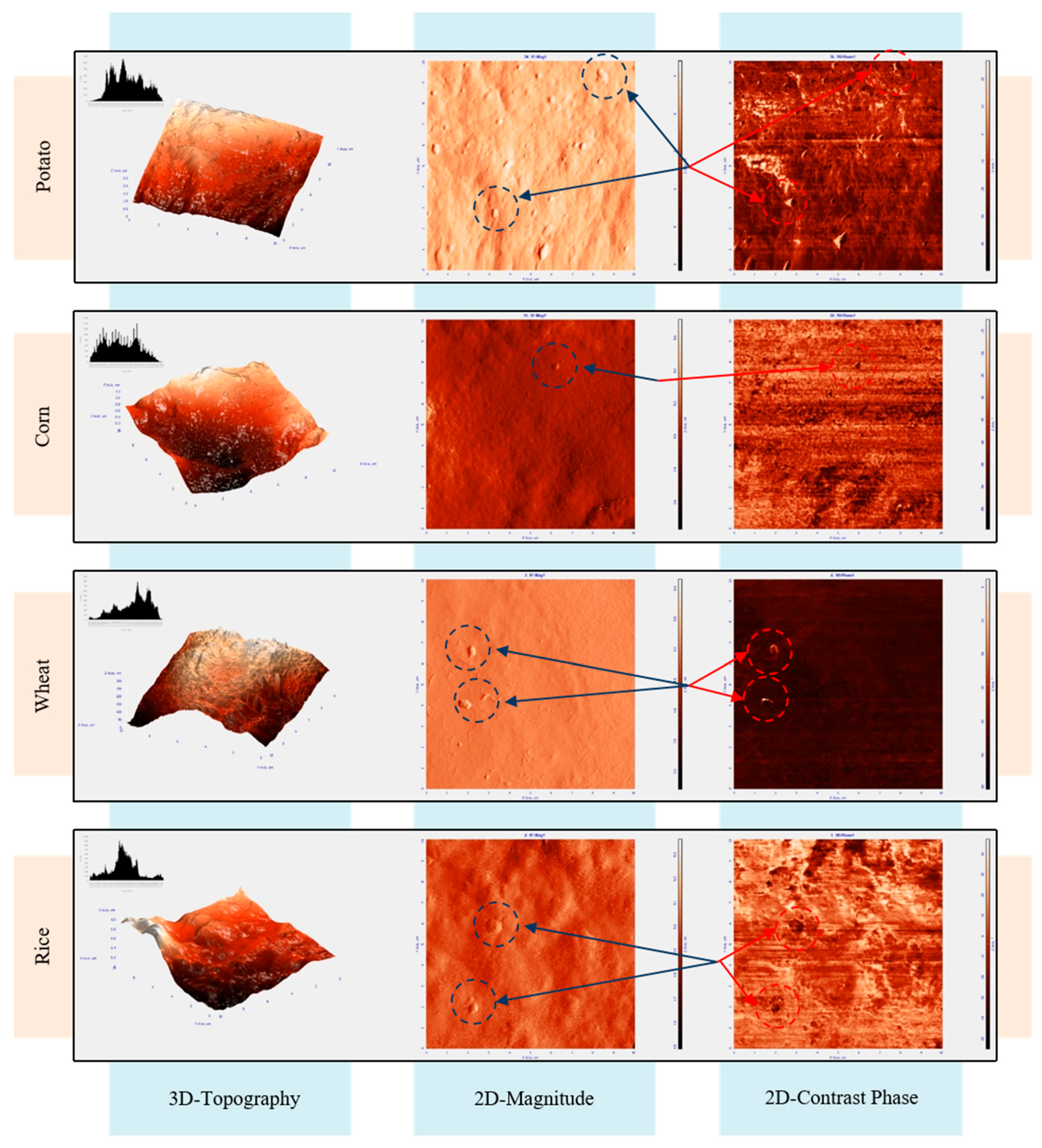
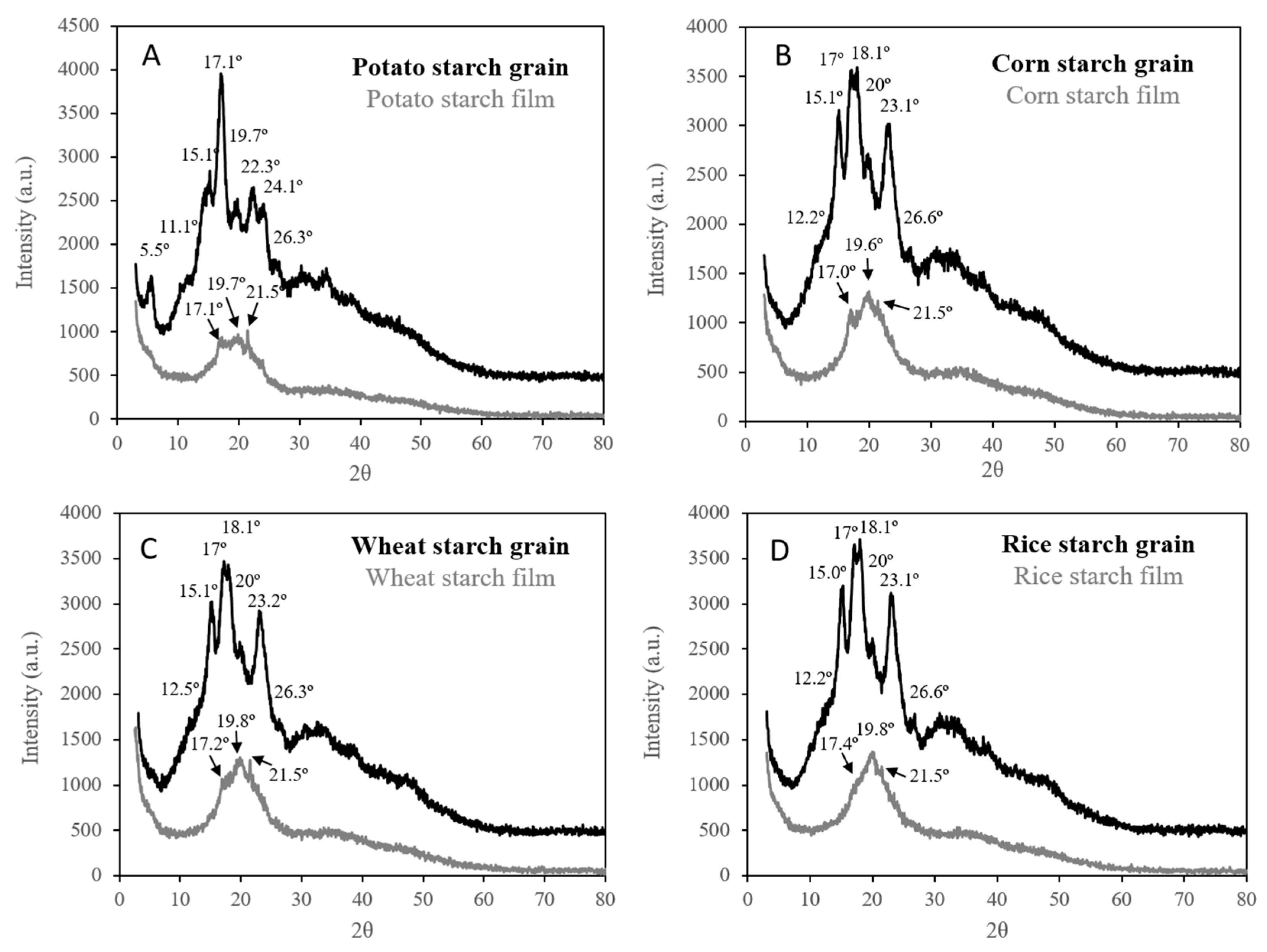
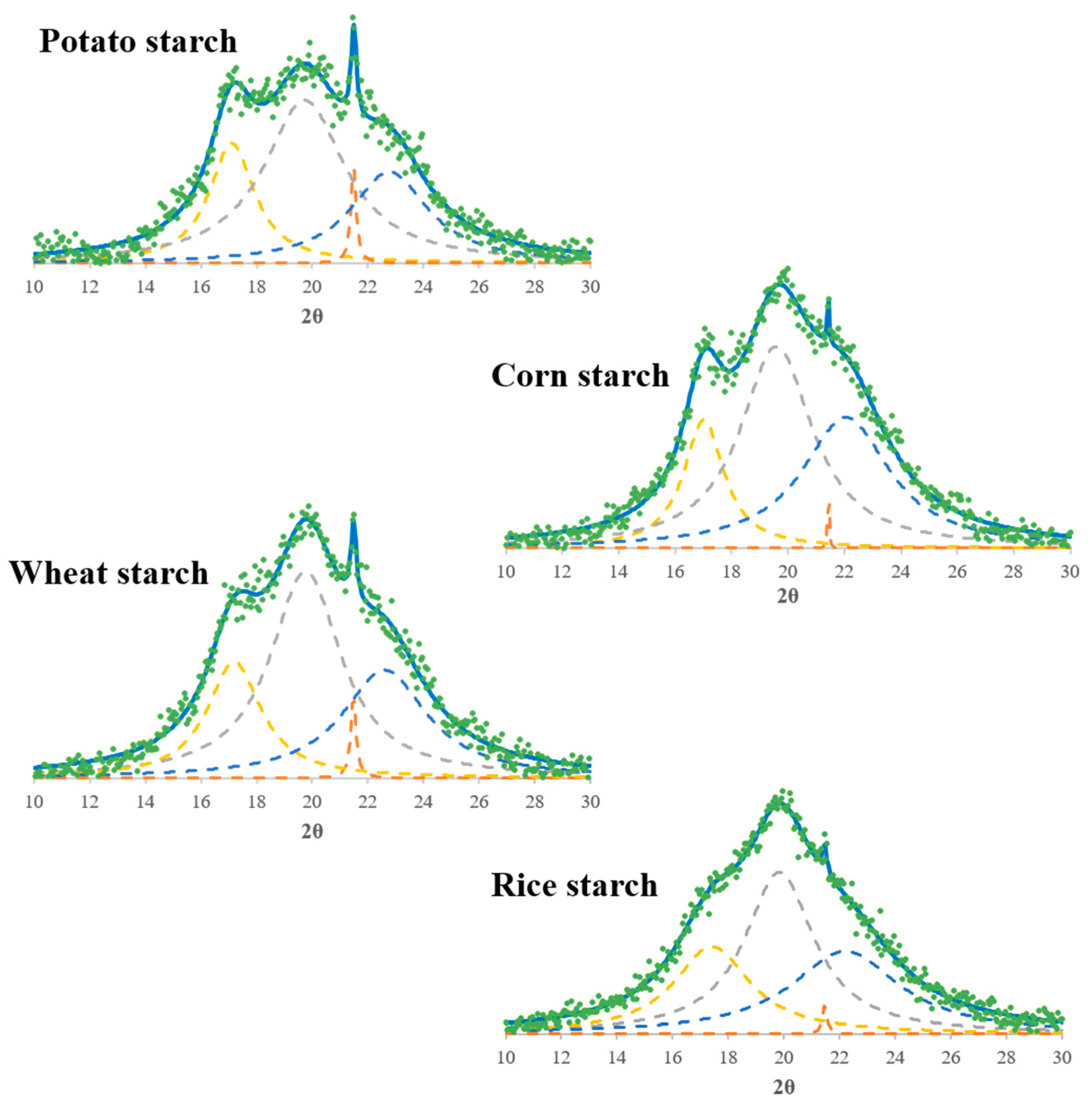
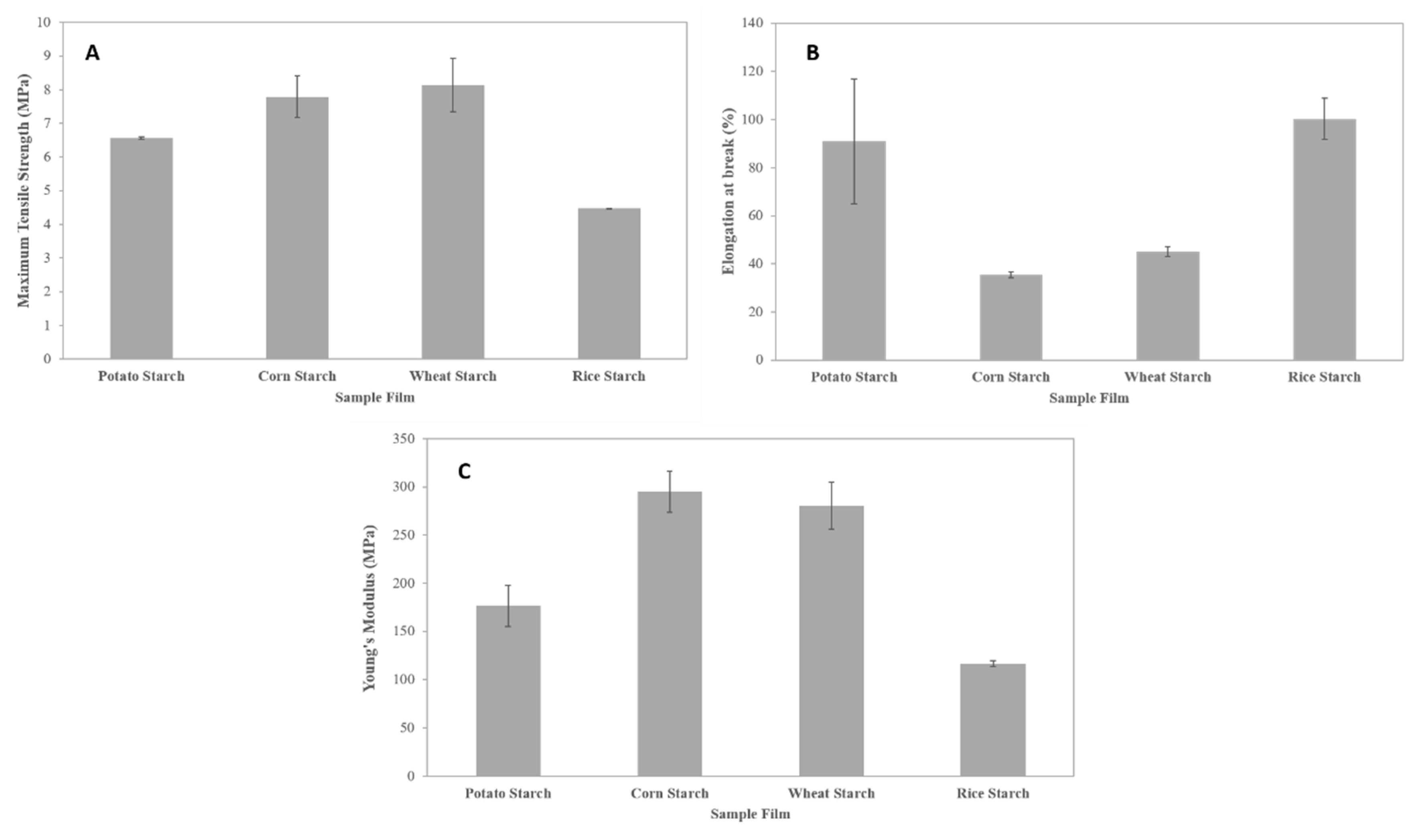
| Starch | D(0.1) (µm) | D(0.5) (µm) | D(0.9) (µm) | Average Diameter (µm) | Span |
|---|---|---|---|---|---|
| Potato | 24.50 ± 0.02 | 42.67 ± 0.04 | 72.58 ± 0.09 | 46.02 ± 0.05 | 1.127 ± 0.001 |
| Corn | 9.76 ± 0.11 | 15.50 ± 0.24 | 24.25 ± 0.92 | 16.38 ± 0.33 | 0.934 ± 0.051 |
| Wheat | 12.17 ± 0.03 | 19.60 ± 0.04 | 30.96 ± 0.06 | 20.75 ± 0.04 | 0.959 ± 0.001 |
| Rice | 5.49 ± 0.22 | 16.22 ± 1.56 | 52.32 ± 4.71 | 23.30 ± 2.09 | 2.887 ± 0.013 |
| Sample Film | Thickness (mm) | Water Content (%) | Water Solubility (%) | Opacity (A600/mm) |
|---|---|---|---|---|
| Potato | 0.183 ± 0.014 | 14.40 ± 0.34 | 29.74 ± 0.24 | 0.61 ± 0.06 |
| Corn | 0.216 ± 0.012 | 10.78 ± 0.68 | 27.88 ± 0.58 | 1.56 ± 0.01 |
| Wheat | 0.222 ± 0.009 | 12.65 ± 0.57 | 32.57 ± 2.04 | 0.93 ± 0.07 |
| Rice | 0.211 ± 0.024 | 12.39 ± 0.59 | 32.25 ± 2.74 | 0.90 ± 0.07 |
| Potato Starch | Corn Starch | Wheat Starch | Rice Starch | |||||
|---|---|---|---|---|---|---|---|---|
| 2θ | Width | 2θ | Width | 2θ | Width | 2θ | Width | |
| Peak 1 | 17.10 | 1.98 | 17.00 | 1.74 | 17.20 | 2.35 | 17.40 | 3.30 |
| Peak 2 | 19.70 | 3.56 | 19.60 | 3.10 | 19.75 | 3.09 | 19.85 | 3.01 |
| Peak 3 | 21.50 | 0.24 | 21.45 | 0.18 | 21.50 | 0.24 | 21.45 | 0.20 |
| Peak 4 | 22.75 | 3.38 | 22.05 | 3.76 | 22.60 | 3.69 | 22.20 | 4.70 |
© 2019 by the authors. Licensee MDPI, Basel, Switzerland. This article is an open access article distributed under the terms and conditions of the Creative Commons Attribution (CC BY) license (http://creativecommons.org/licenses/by/4.0/).
Share and Cite
Domene-López, D.; García-Quesada, J.C.; Martin-Gullon, I.; Montalbán, M.G. Influence of Starch Composition and Molecular Weight on Physicochemical Properties of Biodegradable Films. Polymers 2019, 11, 1084. https://doi.org/10.3390/polym11071084
Domene-López D, García-Quesada JC, Martin-Gullon I, Montalbán MG. Influence of Starch Composition and Molecular Weight on Physicochemical Properties of Biodegradable Films. Polymers. 2019; 11(7):1084. https://doi.org/10.3390/polym11071084
Chicago/Turabian StyleDomene-López, Daniel, Juan Carlos García-Quesada, Ignacio Martin-Gullon, and Mercedes G. Montalbán. 2019. "Influence of Starch Composition and Molecular Weight on Physicochemical Properties of Biodegradable Films" Polymers 11, no. 7: 1084. https://doi.org/10.3390/polym11071084
APA StyleDomene-López, D., García-Quesada, J. C., Martin-Gullon, I., & Montalbán, M. G. (2019). Influence of Starch Composition and Molecular Weight on Physicochemical Properties of Biodegradable Films. Polymers, 11(7), 1084. https://doi.org/10.3390/polym11071084





